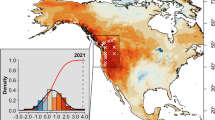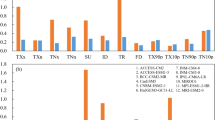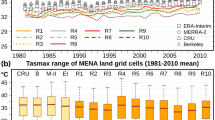Abstract
The summer of 2013 was the hottest on record in Eastern China. Severe extended heatwaves affected the most populous and economically developed part of China and caused substantial economic and societal impacts1. The estimated direct economic losses from the accompanying drought alone total 59 billion RMB (ref. 2). Summer (June–August) mean temperature in the region has increased by 0.82 °C since reliable observations were established in the 1950s, with the five hottest summers all occurring in the twenty-first century. It is challenging to attribute extreme events to causes3,4,5,6. Nevertheless, quantifying the causes of such extreme summer heat and projecting its future likelihood is necessary to develop climate adaptation strategies7. We estimate that anthropogenic influence has caused a more than 60-fold increase in the likelihood of the extreme warm 2013 summer since the early 1950s, and project that similarly hot summers will become even more frequent in the future, with fully 50% of summers being hotter than the 2013 summer in two decades even under the moderate RCP4.5 emissions scenario. Without adaptation to reduce vulnerability to the effects of extreme heat, this would imply a rapid increase in risks from extreme summer heat to Eastern China.
This is a preview of subscription content, access via your institution
Access options
Subscribe to this journal
Receive 12 print issues and online access
$209.00 per year
only $17.42 per issue
Buy this article
- Purchase on Springer Link
- Instant access to full article PDF
Prices may be subject to local taxes which are calculated during checkout




Similar content being viewed by others
References
China Meteorological Administration, China Climate Bulletin 2013 p50 (China Meteorological Administration, 2014).
Hou, W. et al. Climatic characteristics over China in 2013. Meteorol. Mon. 40, 491–501 (2014).
Seneviratne, S. I. et al. in Managing the Risks of Extreme Events and Disasters to Advance Climate Change Adaptation (eds Field, C. B. et al.) 109–230 (Cambridge Univ. Press, 2012).
Bindoff, N. L. et al. in Climate Change 2013: The Physical Science Basis (eds Stocker, T. F. et al.) 910–916 (IPCC, Cambridge Univ. Press, 2013).
Peterson, T. C., Stott, P. A. & Herring, S. Explaining extreme events of 2011 from a climate perspective. Bull. Am. Meteorol. Soc. 93, 1041–1067 (2012).
Peterson, T. C., Hoerling, M. P., Stott, P. A. & Herring, S. Explaining extreme events of 2012 from a climate perspective. Bull. Am. Meteorol. Soc. 94, S1–S74 (2013).
Stott, P. A. et al. in Climate Science for Serving Society: Research, Modelling and Prediction Priorities (eds Asrar, G. R. & Hurrell, J. W.) 307–337 (Springer, 2013).
Zhang, X., Zwiers, F. W. & Stott, P. A. Multimodel multisignal climate change detection at regional scale. J. Clim. 19, 4294–4307 (2006).
Zwiers, F. W., Zhang, X. & Feng, J. Anthropogenic influence on extreme daily temperatures at regional scales. J. Clim. 24, 881–892 (2011).
Wen, H. Q., Zhang, X., Xu, Y. & Wang, B. Detecting human influence on extreme temperatures in China. Geophys. Res. Lett. 40, 1171–1176 (2013).
Stott, P., Sone, D. A. & Allen, M. R. Human contribution to the European heatwave of 2003. Nature 432, 610–613 (2004).
Dole, R. et al. Was there a basis for anticipating the 2010 Russian heat wave. Geophys. Res. Lett. 38, L06702 (2011).
Otto, F. E. L., Massey, N., van Oldenborgh, G. J., Jones, R. G. & Allen, M. R. Reconciling two approaches to attribution of the 2010 Russian heat wave. Geophys. Res. Lett. 39, L04702 (2012).
Van Vuuren, D. P. et al. The representative concentration pathways: An overview. Climatic Change 109, 5–31 (2011).
Sun, Y. & Ding, Y. H. A projection of future changes in summer precipitation and monsoon in East Asia. Sci. China Earth Sci. 53, 284–300 (2010).
Dai, A. et al. The relative roles of upper and lower tropospheric thermal contrasts and tropical influences in driving Asian summer monsoons. J. Geophys. Res. 118, 7024–7045 (2013).
Taylor, K. E., Stouffer, R. J. & Meehl, G. A. An overview of CMIP5 and the experiment design. Bull. Am. Meteorol. Soc. 93, 485–498 (2012).
Allen, M. R. & Tett, S. F. B. Checking for model consistency in optimal fingerprinting. Clim. Dynam. 15, 419–434 (1999).
Allen, M. R., Stott, P. A., Mitchell, J. F. B., Schnur, R. & Delworth, R. S. Quantifying the uncertainty in forecasts of anthropogenic climate change. Nature 407, 617–620 (2000).
Ren, G. Y., Zhou, Y. Q. & Chu, Z. Urbanization effects on observed surface air temperature trends in North China. J. Clim. 21, 1333–1348 (2008).
Yang, X., Hou, Y. & Chen, B. Observed surface warming induced by urbanization in east China. J. Geophy. Res. 116, D14113 (2011).
Ren, G. Y. & Zhou, Y. Q. Urbanization effects on trends of extreme temperature indices of national stations over mainland China, 1961–2008. J. Clim. 27, 2340–2360 (2014).
Solomon, S., Plattner, G., Knutti, R. & Friedlingstein, P. Irreversible climate change due to carbon dioxide emissions. Proc. Natl Acad. Sci. USA 106, 1704–1709 (2009).
Allen, M. R. & Stott, P. A. Estimating signal amplitudes in optimal fingerprinting. Part I: Theory. Clim. Dynam. 21, 477–491 (2003).
Hegerl, G. C. et al. Multi-fingerprint detection and attribution of greenhouse-gas and aerosol-forced climate change. Clim. Dynam. 13, 613–634 (1997).
Acknowledgements
We thank G. Flato and S. Kharin for their comments on an early draft. Y.S., L.S., T.H., H.Y. and G.R. are supported by China funding agencies through multiple grants: 2012CB955902, GYHY201406020, 2012CB417205, CCSF201342 and GYHY201206012. We acknowledge the Program for Climate Model Diagnosis and Intercomparison and the World Climate Research Programme’s Working Group on Coupled Modelling for their roles in making the WCRP CMIP multi-model data sets available.
Author information
Authors and Affiliations
Contributions
X.Z. and Y.S. designed the analysis. H.W., Y.S., T.H. and H.Y. conducted the analysis. Y.S. and X.Z. wrote the initial draft. F.W.Z. and L.S. helped with the analysis and edited the manuscript. G.R. identified the rural stations for the estimation of urbanization effects in temperature and helped in the analysis and interpretation of urbanization effects.
Corresponding author
Ethics declarations
Competing interests
The authors declare no competing financial interests.
Supplementary information
Rights and permissions
About this article
Cite this article
Sun, Y., Zhang, X., Zwiers, F. et al. Rapid increase in the risk of extreme summer heat in Eastern China. Nature Clim Change 4, 1082–1085 (2014). https://doi.org/10.1038/nclimate2410
Received:
Accepted:
Published:
Issue Date:
DOI: https://doi.org/10.1038/nclimate2410
This article is cited by
-
Historical footprints and future projections of global dust burden from bias-corrected CMIP6 models
npj Climate and Atmospheric Science (2024)
-
Spatio-temporal patterns of hot extremes in China based on complex network analysis
Climate Dynamics (2024)
-
Spatio-temporal Variation Characteristics of Extreme Climate Events and Their Teleconnections to Large-scale Ocean-atmospheric Circulation Patterns in Huaihe River Basin, China During 1959–2019
Chinese Geographical Science (2024)
-
Impacts of natural and anthropogenic forcings on historical and future changes in global-land surface air temperature in CMIP6–DAMIP simulations
Climatic Change (2024)
-
The 2022 Extreme Heatwave in Shanghai, Lower Reaches of the Yangtze River Valley: Combined Influences of Multiscale Variabilities
Advances in Atmospheric Sciences (2024)



